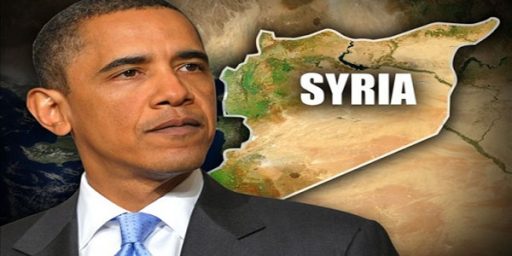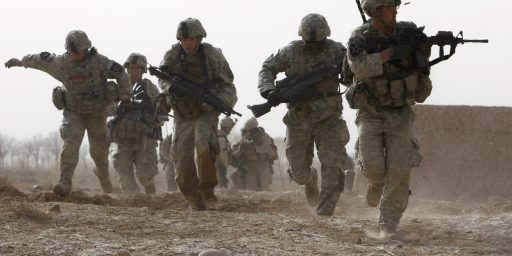Small Armies and Small Wars
Robert Farley has some interesting thoughts on the implications the smaller, more modern forces the major Western powers have for their ability to handle counterinsurgency missions.
Why is it that the United Kingdom, which is in an absolute sense far more wealthy now than it was in 1930, having difficulty maintaining a foreign deployment of about 10000 total in Iraq and Afghanistan, while in 1930 it deployed many multiples of that total all over the world, plus colonial auxiliaries who were partially paid for by the Crown? The relative increase in the effectiveness of insurgency strategies isn’t just a consequence of the spread of the AK-47 or of the further development of nationalism in the non-western world; it’s also a consequence of the fact that modern, wealthy states can now deploy far, far lower numbers of troops than they could fifty years ago. Indeed, in 1965 the United States (with a smaller and much poorer population in absolute terms) managed to deploy half a million troops to Vietnam while at the same time maintaining large contingents in West Germany and South Korea.
He’s right that the end of conscription and the general trend toward replacing mass firepower with well-equipped, highly trained forces mean we will necessarily have fewer “boots” available for deployment for these missions. We’ve seen the implications of this on operations tempo over the last fifteen or so years.
Certainly, small armies can fight small wars. The Marines proved that decades ago and our Special Forces prove it daily. Indeed, there’s much to be said for a small footprint force of quiet professionals. On the other hand, a massive number of soldiers can be quite helpful when trying to establish security over a large area.
Via Tom Grant, who had some thoughts on this matter back in 2004.






Well he’s right about the trend to downsize our fighting forces with smarter and more efficient weapons, but I don’t think the end of conscription has much to do with the issue. In a different political climate in the early 80’s there was a renewed pride in military service, enlistments were rising, and morale was generally good. Recruitment standards were being raised and the quality of officers and enlistees was improving.
There was a two-fold cause to our problems today. First, the post-cold war peace dividend that was cashed in by reducing the size of the armed forces and secondly, the change in national strategy to being prepared and able to fight in two theaters “nearly simultaneously,” did untold damage to today’s forces. Fewer ships, fewer divisions, fewer aircraft, and slowing procurement to replace and refurbish aging equipment have all led to a military that is stretched much thinner than it should be. With longer deployments, shorter turn-around times and a much more active reserve force we have made military service desirable to fewer people.
The draft ended over 30 years ago, but you are right on your observation that it is over the past 10-15 years that the Op tempo has been affected. I would simply argue that it was the Clinton draw-down and not the end of conscription that caused it. And I don’t mean to bash Clinton. Bush Sr. would have cashed in that peace dividend the same way.
Quantity has a quality all its own.
It really depends on what you are trying to do. If you want to break certain things and kill selected people, the small foot print can work very well. If you want to provide enough stability that a new country can get started with new to them concepts like freedom and democracy, the small foot print is not the best tool. Just as a hammer makes a lousy screwdriver, a screwdriver makes a lousy hammer. You need to have the right tool for the job.
Oceanguy is right that the decision to reduce the size of our military in terms of people and things has meant that we don’t have as wide a variety of tools available in our toolbox.